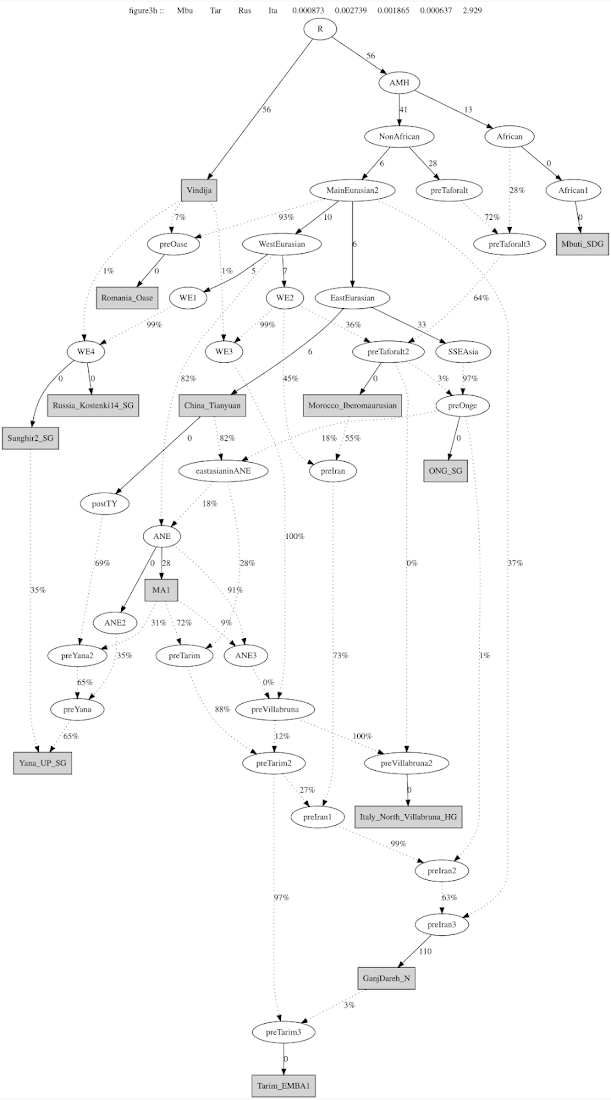From Hallast, P., Agdzhoyan, A., Balanovsky, O. et al. A Southeast Asian origin for present-day non-African human Y chromosomes. Hum Genet 140, 299–307 (2021). https://doi.org/10.1007/s00439-020-02204-9
A very good paper which throws some light on the post out of africa peopling of Eurasia, based on analysis of Y- haplogroups of ancient as well as modern samples.
Here, we show that phylogenetic analyses of haplogroup C, D and FT sequences, including very rare deep-rooting lineages, together with phylogeographic analyses of ancient and present-day non-African Y chromosomes, all point to East/Southeast Asia as the origin 50,000–55,000 years ago of all known surviving non-African male lineages (apart from recent migrants). This observation contrasts with the expectation of a West Eurasian origin predicted by a simple model of expansion from a source near Africa, and can be interpreted as resulting from extensive genetic drift in the initial population or replacement of early western Y lineages from the east, thus informing and constraining models of the initial expansion.
The reasoning for their claim of South eastern origin for male lineages in nonafricans is as follows
In a simple model of gradual human expansion from Africa to Asia and Oceania without subsequent continental-scale reshaping, we would expect the initial divergences in the Y-chromosomal phylogeny to have occurred in geographical locations close to Africa, and the present-day Y-chromosomal phylogeography to reflect this history by showing the presence of the early-diverging lineages within C, D and FT now being located geographically in Central/West Asia (Fig.3a), with lower lineage diversity further east. In stark contrast, the observed distributions of these lineages all lie further to the east, suggesting that a simple model of this kind cannot explain the observed present-day dataThis makes perfect sense. There probably was a male lineage replacement which happened from E/SE Asia, replacing the old Y lineages of Eurasia. AASI (Ancient ancestral South Indians) is a hypothetical ancient indian population which hasnt been sampled yet. AASI have the andamanese tribals as their genetically closest sampled population (but still distant due to isolation and genetic drift). AASI almost definitely also arrived in Indian subcontinent from this eastern route after the OoA event. This qpgraph generated by me makes it clear. Notice that worst f-statistic has Z score below |3|, so the model is good, but by no means the only passing model. But we can see that Onge is nested firmly within the East Eurasian tree, of which Tianyuan (east china ~39kya sample) is a part.
Please click on graph to get high res image (Mobile view is best).
| qpGraph parameters: fstatsname: fstatsa.txt outpop: NULL useallsnps: YES blgsize: 0.05 forcezmode: YES lsqmode: NO diag: .0001 bigiter: 6 hires: YES lambdascale: 1 precision: 0.0001 initmix: 1000 zthresh: 3.0 terse: NO Shaded boxes are actual populations, oval unshaded boxes are hypothetical populations need to reduce errors on the graph. |


10 comments:
I will make another post detailing why I think northwest india, Iran and SC asia were probably inhabited by basal eurasians (ancestral node to west and east eurasians) in the Initial upper paleolithic era.
When & where you going to make post? Please notify me
@Vashistha
What is the Rakhigarhi's "Iranian-related" ancestry (RIR ancestry). I read somewhere that Granj-Dareh itself is 50% ANE. We know that likely comes from the same ancestry as the Rakhigarhi's "Iranian-related" ancestry.
Following the logic that the RIR ancestry should have had a lot more ANE. Would it be okay to postulate that some form of ANE already existed in South Asia prior to the mixing of RIR with AASI. Admixture period given by Narasimhan is 3700-5300BCE.
Anyway to model the Rakhigarhi aDNA with ANE as a source? I am curious to see what we had in IVC prior to the admixture with AASI.
make sense and looks reliable to me.
In a day or so
The next post that I will make will cover this question. There is no doubt that RIR as you call it is different from Ganj Dareh neolithic.
https://a-genetics.blogspot.com/2021/11/install-admixtools.html
How to install Admixtools
Hakon, thanks for your comment
If AASI came from East I wonder what happened to humans that came post toba into the sub continent? And what relationship they had with AASI?
African and basal human ancestry is part of the IranN and IndiaN neolithic populations.. nothing to do directly with aasi. aasi is pure est eurasian
Post a Comment